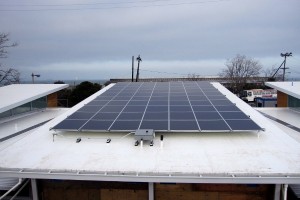The Best Fit: aluminum framing systems reduce installation time and costs
Project Frog in San Francisco is a clean technology company that incorporates a sophisticated approach — including parametric design, precision fabrication, energy modeling, lean manufacturing and continuous monitoring — to create sustainable, efficient structures that reduce overall operating costs and also meet stringent LEED requirements.
Project Frog was chosen to create a 5,000-sq-ft building in Hunters Point, an evolving neighborhood in the southeastern part of San Francisco. Formerly the site of a naval shipyard that includes more than 700 acres of waterfront property, Hunters Point is currently undergoing significant redevelopment to transition into residential, commercial and recreational areas. The new building, located on the edge of the bay facing the majestic city skyline, is the area’s community hub, serving as a convenient meeting space that can also be used for educational purposes.
 Project Frog’s solution is visually attractive with design features that reflect the character of a distinctive urban neighborhood. Thoughtful selection of colors, textures and other details of the building and surrounding landscape ensures connectivity to future development of the area.
Project Frog’s solution is visually attractive with design features that reflect the character of a distinctive urban neighborhood. Thoughtful selection of colors, textures and other details of the building and surrounding landscape ensures connectivity to future development of the area.
As part of its strategy to improve energy efficiency, Project Frog turned to Bosch Solar Energy Group to supply PV technology for the roof of the new community center. The rooftop array is comprised of 70 micromorph thin-film solar modules mounted and installed using the Bosch Solar Rack, a convenient slide-in mounting system developed jointly with the Bosch Rexroth Corp. Offered as a standard product, the slide-in Bosch Solar Rack is designed around Rexroth’s broad line of aluminum structural framing components and can be customized for a given installation.
The black-glass appearance of the panels, combined with the low-profile racking system, proved to be an ideal match to the architecture of the Project Frog building, while also providing a source of clean renewable energy.
“Bosch Solar Energy micromorph thin-film technology is ideal for the building due to the exceptional performance of thin film under the low light conditions that can occur during foggy days in the San Francisco Bay-area,” says John Saussele, director of Bosch Solar Energy Group. According to Ash Notaney, vice president of supply chain for Project Frog, the array generates 25 percent of the energy required to operate the building over the course of a year.
Although crystalline silicon has traditionally been used in PV technology and can easily convert sunlight into energy, thin-film modules are less costly to produce, more flexible and lighter than crystalline silicon modules. Crystalline technology is more suitable for applications requiring higher power density.
The panels are roughly 3 ft by 4 ft, and the frameless design of the modules was an excellent fit for the slide-in racking system, which was created with Rexroth’s bolt-together aluminum structural framing. Rexroth provides more than 120 different extruded aluminum profiles that can be easily combined for applications ranging from lean manufacturing workstations to architectural framing for sustainable residential housing. The aluminum profiles require no specialized tools to create virtually any structure desired. As a result, Rexroth’s framing system adapts easily for each solar installation based on the physical environment and space limitations.
Rexroth aluminum structural framing is weather-resistant, enabling it to withstand the elements of the San Francisco Bay-area. Its rugged design contributes to the durability of each installation but also helps aesthetically, continuing to look clean and neat over time without requiring additional painting or other maintenance.
The design of the Solar Rack mounting system resulted in a large rectangular array that fit perfectly to the dimensions of the center rooftop of the building. The mounting points were integrated in the Project Frog roof, which allowed the solar array to follow the roofline and slope to the south, improving the power output of the system. “Because the building had a membrane roof, we designed the structure to hold the solar panels around stand-offs,” says Steve Kirnig, district distribution manager for Bosch Rexroth.
“Typically, when photovoltaics are installed on a membrane roof of this size, there can be up to 200 places where the mounting system that holds the array penetrates the roof to secure the structure,” Notaney says. “Working with Rexroth’s engineering team, we were able to increase the length of the racking profiles to span a larger distance and bear directly on our own trusses. This allowed us to drastically reduce the number of roof penetrations to 21 locations.”
According to Kirnig, some of the aluminum profiles were cut to length at the jobsite to speed up installation and ensure correct dimensions. Once the framing system was in place, it took only two workers about one to two minutes to install each panel, including mounting the stops. Since installation and brackets are no longer required, material costs are also reduced by about 40 percent.
Working with Bosch Solar Energy Group and Rexroth resulted in significant time and cost savings for Project Frog. “We were able to co-design a standardized solar array and mounting system which efficiently connects with Frog structural components resulting in a cost savings of more than 40 percent and cut installation time in half, compared to a similar project,” Notaney says. “The repetitive nature of the Frog system means the savings to our customers will only continue to grow.”





Comments are closed here.